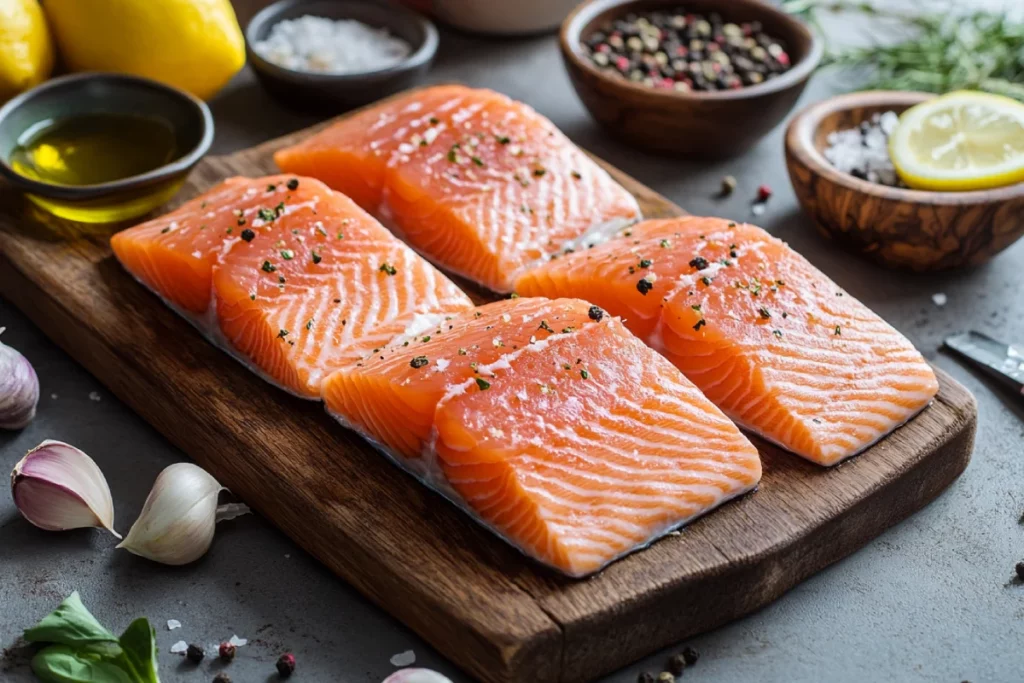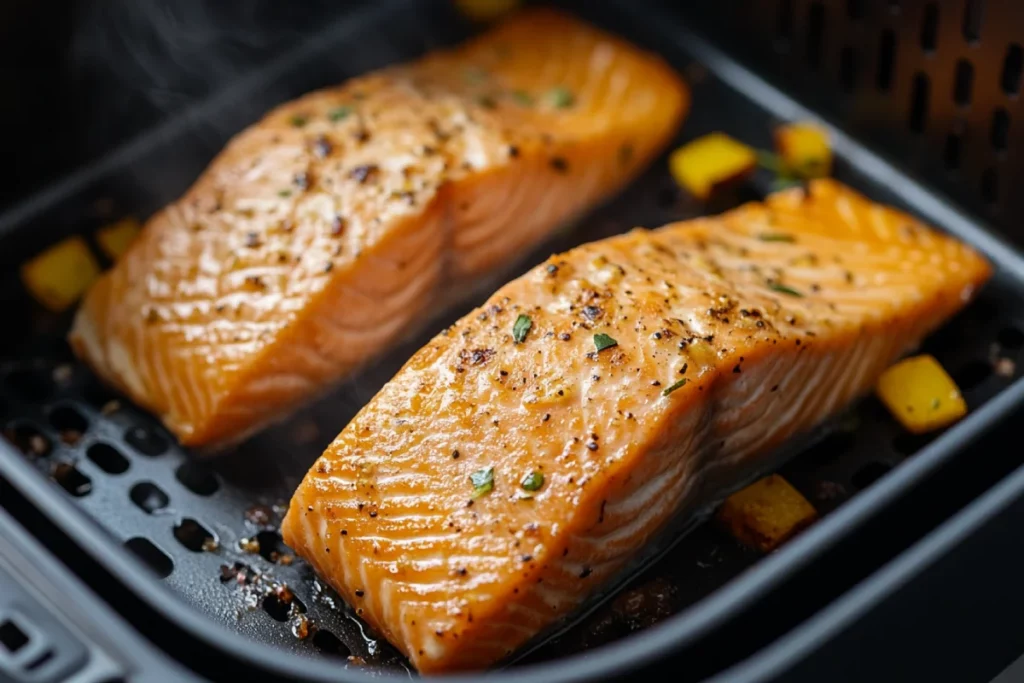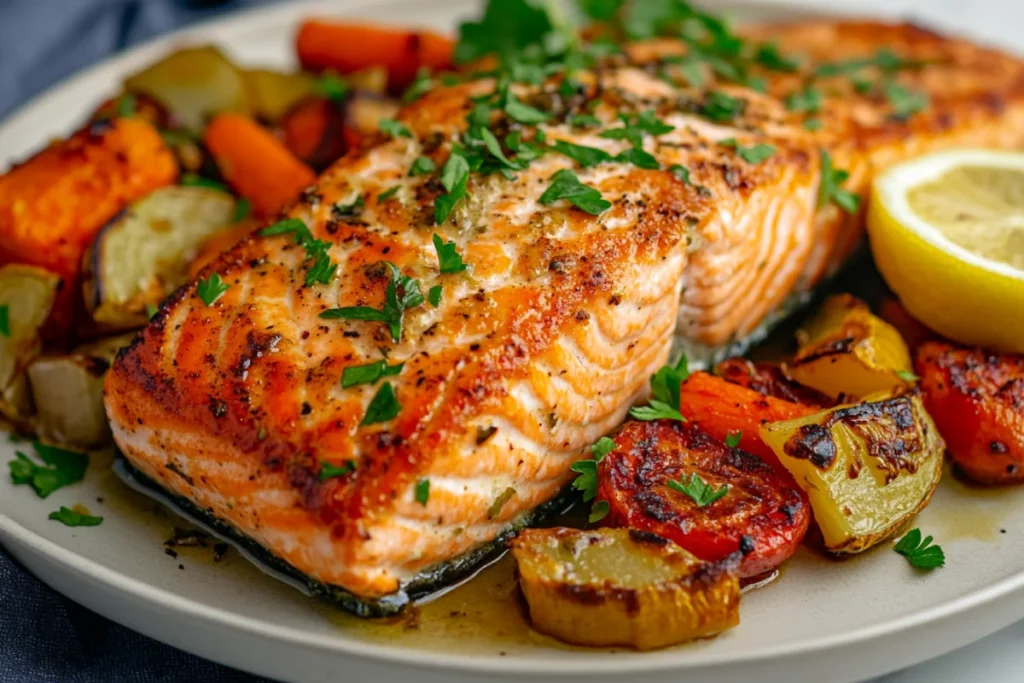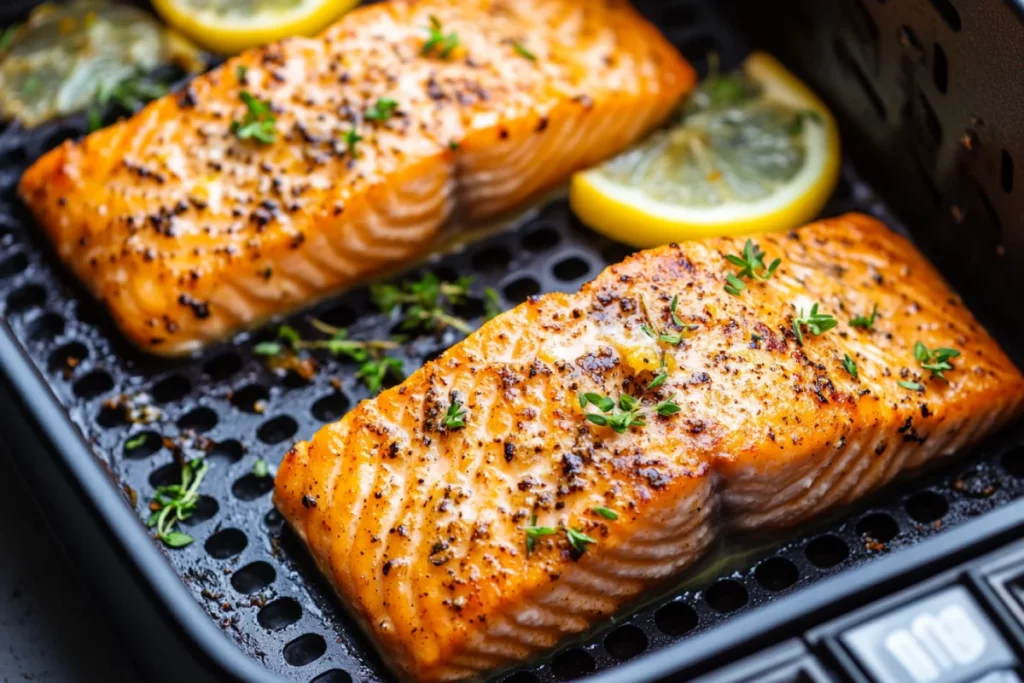Frozen Salmon in Air Fryer is a simple way to enjoy a healthy, flavorful meal without the need for defrosting. Whether you’re short on time or forgot to thaw your fillets, this method delivers tender, flaky salmon with a crisp finish in under 20 minutes. With the right technique, you can go straight from freezer to plate using ingredients you likely already have in your kitchen. In this guide, you’ll learn why the air fryer is perfect for frozen salmon, how to prepare it properly, what temperature and time work best, and how to serve it up with delicious sides.
Why Air Fryer is Perfect for Cooking Frozen Salmon
Why air fryer works well for frozen fish
An air fryer creates the ideal environment for cooking frozen fish like salmon. The rapid hot air circulation helps evenly cook the salmon without drying it out. While traditional ovens or pans might leave the center cold or the outside rubbery, the air fryer gives a firm, crisp texture on the outside with moist flakes inside.
This even cooking is particularly helpful when you’re working with frozen fillets. Since you don’t need to defrost the salmon first, you save time and reduce food waste. Most air fryer baskets also have nonstick coatings, which means less oil is needed—perfect for heart-healthy meals.
Time-saving and health benefits of using an air fryer
One of the biggest advantages of using an air fryer is speed. Frozen salmon typically takes less than 15 minutes to cook, depending on the thickness. That’s significantly quicker than oven-baking or grilling from frozen.
Beyond saving time, air frying salmon is healthier than pan-frying or deep-frying. You’ll use little to no oil, cutting down on excess calories and fat. The high-heat environment helps lock in the fish’s natural juices and nutrients, including omega-3 fatty acids and protein, while keeping the texture crisp and enjoyable.
Plus, cleanup is minimal. No pans, no oil splatters, and no messy grill plates—just one basket that wipes clean easily.
Preparing Frozen Salmon for the Air Fryer
No thaw needed: what to do instead
The beauty of cooking frozen salmon in the air fryer is skipping the defrosting step. That means less waiting and fewer prep steps. Still, it’s important to prep the fillets the right way to get the best texture and flavor.
Start by removing any ice glaze on the surface. Rinse the salmon under cold water for a few seconds, then pat it dry with paper towels. This helps seasonings stick and prevents steam from forming during cooking, which can lead to soggy fish.
If your salmon has skin, place the skin side down when cooking. It protects the flesh from the direct heat and crisps up nicely. If your fillets are individually vacuum sealed, be sure to remove all packaging before air frying.
Don’t forget to preheat your air fryer. This helps create that hot, circulating air right from the start, which is crucial for evenly cooking frozen fish.
Recommended seasonings and marinades for frozen fillets
Seasoning frozen salmon is straightforward, but using the right flavors helps it shine. Since the fillets are still cold, rub the seasoning on right after drying them. Here are some go-to combos:
Simple Garlic & Herb Blend
- Olive oil spray or brush
- Garlic powder
- Dried parsley
- Salt and black pepper
- Lemon slices placed on top after cooking
Soy-Ginger Glaze (for Asian-style flavor)
- Light soy sauce
- Fresh or ground ginger
- Sesame oil
- Brown sugar or honey
- Sprinkle of sesame seeds after cooking
Spicy Cajun Rub
- Olive oil
- Cajun seasoning
- Smoked paprika
- Black pepper
- Squeeze of lime juice after air frying
You can also use pre-made spice blends or marinades, but avoid those high in sugar if air frying—sugars can burn at high heat. If you’re using a thicker sauce (like teriyaki or BBQ), wait until the last 2–3 minutes of cooking to brush it on.

Air Frying Frozen Salmon Step-by-Step
Equipment and ingredients needed
Before you begin, make sure you have everything ready for a smooth cooking process. The key to a perfect frozen salmon in air fryer dish is having the right tools and ingredients on hand.
Essential Equipment
- Air fryer (basket or tray-style, 4-quart or larger preferred)
- Tongs or a spatula
- Cooking thermometer (optional but helpful)
Ingredients
- Frozen salmon fillets (skin-on or skinless)
- Olive oil or avocado oil spray
- Your choice of seasoning or marinade
- Lemon or lime slices (for serving)
- Fresh herbs (like dill or parsley) – optional
You don’t need foil or parchment unless your air fryer basket sticks. Most newer models are non-stick by design. Avoid overcrowding—cook 1–2 fillets at a time depending on your air fryer’s size.
Cooking instructions from frozen to done
Follow these steps to cook your frozen salmon quickly and evenly every time:
- Preheat air fryer
Set your air fryer to 400°F and let it preheat for 3–5 minutes. A hot basket helps give the salmon a crisp exterior from the start. - Prepare salmon
Remove any packaging. Run the fillets briefly under cold water to melt surface ice. Pat dry with paper towels. Lightly spray or brush both sides with oil. Season both sides using your chosen rub or spices. - Place in air fryer
Lay fillets skin-side down in the air fryer basket. Make sure they aren’t touching. Air needs to circulate freely for even cooking. - Cook time
Cook at 400°F for 7–9 minutes. Then, flip (optional if skin-on) and continue cooking for 5–6 more minutes. Total time ranges from 12–15 minutes depending on thickness (see Part 4 for full timing table). - Check for doneness
Salmon is done when it flakes easily with a fork and reaches 125°F–130°F internal temperature. If unsure, cut into the thickest part and check the center. - Serve hot
Let it rest for 2–3 minutes. Then squeeze lemon over the top and add herbs if desired. Serve with your favorite side.
This method works for most cuts—fillets, steaks, or portions. For extra-crispy edges, increase cooking time by 1–2 minutes after flipping.

Frozen Salmon in Air Fryer at 400°F – Timing Tips
How long to cook frozen salmon at 400°F
Cooking frozen salmon in an air fryer at 400°F is one of the fastest and most reliable methods. The high heat ensures a crisp outer layer while locking in moisture inside. Timing, however, depends on the thickness of your fillets and whether they’re skin-on or skinless.
Here’s a quick reference table to guide you:
Fillets with skin may take 1–2 minutes longer. You’ll know it’s ready when it flakes easily and has a light pink, opaque center.
Adjusting cook time based on thickness and air fryer model
Different air fryer models cook at slightly different speeds. Basket-style fryers tend to cook a little faster than oven-style ones because they circulate air more efficiently around smaller areas.
If you’re using a compact air fryer or cooking more than one fillet at a time, you might need to add 2–3 extra minutes.
Also, pay attention to salmon thickness:
- Thin fillets (under 1 inch): Start checking around the 10-minute mark.
- Thicker fillets: Always use a meat thermometer or do a flake test at the center.
For best results, keep space between fillets so heat can circulate fully. Overcrowding leads to uneven cooking and soggy texture.
How to Tell When Your Salmon is Done
Internal temperature and texture cues
Getting frozen salmon in air fryer just right depends on knowing when it’s done. Salmon is fully cooked when the internal temperature reaches 125°F to 130°F for moist, tender texture, or up to 145°F if you prefer it firmer.
Use a digital meat thermometer and insert it into the thickest part of the fillet. Avoid touching the pan or basket with the probe—it could give a false reading.
Aside from temperature, texture is a great visual cue:
- The salmon should flake easily with a fork.
- The color should shift from deep pink to opaque light pink or coral.
- The outer edges will be slightly crisp or golden if seasoned well.
You’ll also notice the surface oils beginning to separate—this is normal and means it’s nearly ready.
If you’re not using a thermometer, cut into the thickest part to check. If it’s still translucent in the middle, return it to the air fryer for 2 more minutes.
What to avoid: Overcooking or undercooking salmon
Salmon can quickly turn dry or rubbery if overcooked, especially in a high-heat air fryer. Stick to the recommended cook times and check early if your fillets are thin.
Signs of overcooked salmon:
- Dry, chalky texture
- Curled or cracked edges
- Strong fishy smell
Signs of undercooked salmon:
- Cool or raw center
- Slick, shiny texture in the middle
- Difficulty flaking with a fork
If the fillets are uneven in size, you can stagger their placement or cut thicker ones in half before cooking. Always let the salmon rest for 2–3 minutes after cooking—this allows juices to settle and finishes the cooking gently.
Pairing Ideas – What to Serve with Frozen Salmon
Simple vegetable and grain pairings
A well-cooked frozen salmon in air fryer deserves flavorful yet simple side dishes. Since salmon is rich and satisfying on its own, go with sides that balance it out without overpowering the flavor.
Top vegetable pairings:
- Air-fried broccoli or asparagus – Toss in olive oil, salt, and garlic powder. Air fry for 6–8 minutes.
- Roasted Brussels sprouts – Crisp and savory with a hint of sweetness when roasted.
- Green beans with almonds – Lightly sautéed or steamed with a sprinkle of sea salt.
Grain options:
- Quinoa – Light, fluffy, and quick to prepare. Add lemon zest for extra brightness.
- Brown rice – A hearty choice that holds sauce well and adds fiber.
- Couscous or orzo – Quick-cooking and ideal for light summer meals.
If you’re short on time, frozen microwaveable brown rice or quinoa packs pair well and require zero cleanup.
Low-carb and family-friendly sides
For low-carb or keto-friendly pairings, think light and fresh. Here are ideas that are fast, kid-approved, and diet-flexible:
Low-carb options:
- Cauliflower rice – Sauté with garlic, onions, and a little butter.
- Zucchini noodles – Quick to sauté, fun for kids, and light on carbs.
- Cabbage steaks or stir-fry – Adds crunch and can be seasoned any way.
Family-friendly pairings:
- Mac and cheese – Especially if you’re feeding kids. Goes well with lemon-dill salmon.
- Sweet potato fries – Cooked in the air fryer while salmon rests. Season with paprika and cinnamon.
- Corn on the cob – Steamed or grilled, it’s a classic side that kids love.
To keep meals balanced, aim for a mix of protein, vegetables, and either a grain or healthy fat. A dollop of Greek yogurt sauce or lemon aioli adds a creamy finish without heavy calories.
For a trending high-protein twist, check out this Chicken Parm Cottage Cheese Bowl.
👉 https://tastywithus.com/chicken-parm-cottage-cheese-bowl/

Common Mistakes to Avoid
Skipping seasoning or not preheating
Even though frozen salmon in air fryer is beginner-friendly, a few simple mistakes can lead to disappointing results. First, don’t forget to season your fillets. Salmon straight from the freezer may look like it won’t hold spices, but drying the surface first allows seasoning to stick. A quick spray of oil helps too.
Many skip preheating the air fryer, assuming it heats up instantly. But starting with a cold air fryer adds 2–3 minutes of uneven cooking. Always preheat for 3–5 minutes to allow consistent air flow and proper texture.
Other seasoning tips:
- Avoid high-sugar marinades at the beginning—they can burn.
- Add fresh lemon, herbs, or sauces after cooking to keep the flavor fresh and prevent bitter overtones.
Overcrowding the basket and other timing issues
It’s tempting to cook multiple fillets at once, especially for families. But packing the air fryer too tightly blocks air circulation, leading to uneven cooking. Instead, cook 1–2 fillets per batch or use a tray-style air fryer with racks.
Spacing matters. Give each fillet enough room on all sides for hot air to move. If you’re in a rush, cook smaller fillets or pre-cut portions instead of full slabs.
More timing tips:
- Check earlier than expected if your fillets are thin.
- Always let the salmon rest 2–3 minutes after cooking. This step keeps it juicy and finishes the cook-through process naturally.
- If reheating leftovers, use 350°F for 3–4 minutes. Avoid microwaving if possible—it dries out the texture quickly.
By following these tips, you’ll prevent rubbery fish, undercooked centers, or burnt edges.
Want a fun fusion meal next? Try the viral Smash Burger Taco recipe.
👉 https://tastywithus.com/smash-burger-taco/
Storage, Reheating, and Leftover Ideas
Proper storage and reheating tips
If you’ve cooked extra frozen salmon in the air fryer, don’t toss the leftovers—salmon stores well and can be used in multiple meals. Here’s how to store and reheat it properly:
Storage:
- Let salmon cool completely before storing.
- Place in an airtight container or wrap tightly in foil.
- Store in the fridge for up to 3 days.
- For longer storage, freeze cooked salmon for up to 2 months. Wrap each portion in parchment paper, then foil, and store in a freezer bag.
Reheating instructions:
- Air fryer: Best method for preserving texture. Set to 350°F and reheat for 3–4 minutes.
- Oven: 300°F for 10–12 minutes, covered loosely with foil to keep it moist.
- Skillet: Medium-low heat with a splash of broth or water, cover with a lid, and warm 3–5 minutes.
- Avoid microwave: It dries out the fish quickly and ruins the flakiness.
Reheating slowly and gently helps retain moisture and flavor.
Easy meals to make with leftover cooked salmon
Leftover salmon is super versatile. It works well in quick lunches, dinner bowls, or even breakfast.
Meal ideas using leftover air fryer salmon:
- Salmon salad: Flake over mixed greens with avocado, cherry tomatoes, and a light vinaigrette.
- Salmon tacos: Warm salmon in a skillet, then serve in corn tortillas with slaw and lime crema.
- Salmon pasta: Toss into warm pasta with garlic, spinach, and olive oil.
- Breakfast scramble: Mix flaked salmon into eggs with chopped veggies.
- Grain bowl: Layer with quinoa, cucumbers, pickled onions, and tahini dressing.
For a quick fix, even a salmon sandwich on sourdough with dill mayo hits the spot.
Leftovers don’t need to feel like “leftovers” when you rework them into fresh, creative dishes.
Frequently Asked Questions
Can you cook salmon from frozen in an
Can you cook salmon from frozen in an air fryer?
Yes, you absolutely can cook salmon from frozen in an air fryer without thawing it first. The air fryer’s rapid hot air circulation helps cook frozen salmon evenly and quickly. Just rinse off any ice, pat the fillets dry, season them, and place them directly into the preheated air fryer. Within 12–15 minutes, you’ll have tender, flaky salmon with a golden edge.
How long to cook salmon at 400 if frozen?
If you’re cooking frozen salmon at 400°F, expect a cook time between 12 to 16 minutes, depending on thickness:
1-inch thick fillets: 12–14 minutes
1.5-inch thick: 14–16 minutes
2-inch thick: up to 18 minutes
Check doneness using a thermometer or fork flake test. Flip the salmon halfway if desired for extra even browning.
How long to cook frozen fish in an air fryer at 400 degrees?
For most types of frozen fish in an air fryer at 400°F, cook times range from:
White fish (like cod or tilapia): 10–12 minutes
Salmon or thicker cuts: 12–16 minutes
Always preheat your air fryer and avoid overcrowding to allow even cooking. Adjust based on the cut, thickness, and whether it’s breaded or plain.
What temperature should I set my air fryer for salmon?
The ideal air fryer temperature for cooking salmon is 400°F. This temperature crisps the outside while cooking the inside evenly without drying it out. If you’re reheating cooked salmon or want a gentler approach, use 350°F for 3–4 minutes.
For thick or skin-on fillets, 400°F gives the best results in under 15 minutes. Preheating ensures the air fryer starts hot enough to cook evenly.
Final Thoughts on Cooking Frozen Salmon in an Air Fryer
Making frozen salmon in air fryer is one of the easiest and most reliable ways to enjoy a healthy, home-cooked meal—even when you forget to defrost. With a quick rinse, some seasoning, and just 12–15 minutes at 400°F, you can go from freezer to dinner table with minimal cleanup and maximum flavor.
We covered everything from prep and cook times to doneness checks and pairing ideas. Whether you’re keeping it simple with veggies and grains, or repurposing leftovers into tacos or salads, air-fried salmon offers flexibility for any lifestyle or diet.
Remember these final tips:
- Always preheat your air fryer.
- Don’t skip drying and seasoning the fillets.
- Check doneness by texture and temperature.
- Store and reheat properly to avoid dry leftovers.
Now that you’ve got the process down, frozen salmon won’t feel like a backup option—it’ll become a regular go-to.



